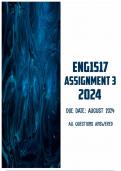, PLEASE USE THIS DOCUMENT AS A GUIDE TO ANSWER YOUR ASSIGNMENT
Please note that the author of this document will not responsibility for any plagiarizing you
commit.
Question 1
1. Read the following short poem and answer the questions that follow.
THE MOON
By Robert Louis Stevenson
The moon has a face like the clock in the hall;
She shines on thieves on the garden wall,
On streets and field and harbour quays*,
And birdies asleep in the forks of the trees.
The squalling cat and the squeaking mouse,
The howling dog by the door of the house,
The bat that lies in bed at noon,
All love to be out by the light of the moon.
But all of the things that belong to the day
Cuddle to sleep to be out of her way;
And flowers and children close their eyes
Till up in the morning the sun shall arise.
(Stevenson, R.L. 2008. ‘The Moon’, in A Child’s Garden of Verses. Project Gutenberg Edition.
Available: https://www.gutenberg.org/ebooks/25609. Accessed on: 2 June 2023).
1.1. Identify the type of rhyme used in the poem. Provide a reason and a quotation from the
poem in support of your answer.
The poem uses end rhyme, where the last words of each line rhyme with each other in pairs. This
creates a pleasing and rhythmic sound when the poem is read aloud.
Quotation from the poem in support of this answer:
"The moon has a face like the clock in the hall;
She shines on thieves on the garden wall,"
Here, "hall" and "wall" rhyme, demonstrating the use of end rhyme.
1.2. Identify the simile in the poem and explain the effect of this simile.
The simile in the poem is found in the first line: "The moon has a face like the clock in the hall."
Effect of this simile:
This simile compares the moon to a clock face, suggesting that the moon is ever-present and watches
over the night just as a clock watches over time. It evokes a sense of constancy and calm, implying
that the moon, like a clock, is a silent observer of all activities. This comparison also adds a touch of
familiarity and domesticity, making the celestial moon feel closer and more relatable to the reader.





